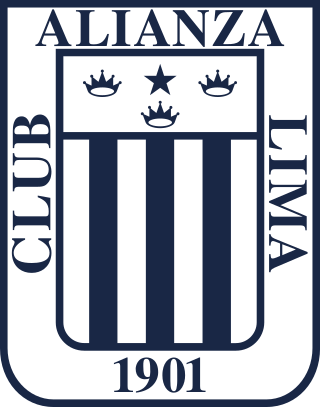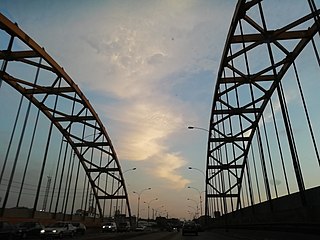
El Comercio is a Peruvian newspaper based in Lima. Founded in 1839, it is the oldest newspaper in Peru and one of the oldest Spanish-language papers in the world. It has a daily circulation of more than 120,000. It is considered a newspaper of record and one of the most influential media in Peru.

The Peru national football team, nicknamed La Blanquirroja, represents Peru in men's international football. The national team has been organised, since 1927, by the Peruvian Football Federation (FPF). The FPF constitutes one of the ten members of FIFA's South American Football Confederation (CONMEBOL). Peru has won the Copa América twice, and has qualified for the FIFA World Cup five times ; the team also participated in the 1936 Olympic football competition and has reached the semi-finals of the CONCACAF Gold Cup. The team plays most of its home matches at the Estadio Nacional in Lima, the country's capital.

The National University of San Marcos is a public research university located in Lima, the capital of Peru. In the Americas, it is the first officially established and the oldest continuously operating university.

Club Alianza Lima, more commonly known as simply Alianza Lima, is a Peruvian professional sports club based in La Victoria District of Lima, Peru. The club was founded under the name of Sport Alianza on 15 February 1901 by working-class youth in the Chacaritas neighborhood of Lima. It is widely known for having one of the most historical and successful football teams in Peru; they have won a total of 25 official league titles of the Peruvian Primera División and are currently the oldest team playing in that competition, since the club was founded in 1901. According to CONMEBOL, it is considered the most popular club in Peru, and the 6th most popular club in South America, with more than 12 million fans as of April 2016.
The Rímac River is located in western Peru and is the most important source of potable water for the Lima and Callao Metropolitan Area. It belongs to the Pacific Slope, into which it flows after bathing the cities of Lima and Callao, together with the Chillón River, to the north, and the Lurín River, to the south. It is 204 km long and has a basin of 3,312 km², of which 2,237.2 km² is a humid basin. The basin has a total of 191 lagoons, of which only 89 have been studied. The river begins in the highlands of the Huarochirí Province in the Lima Region and its mouth is located in Callao, near Jorge Chávez International Airport.

The Historic Centre of Lima is the historic city centre of the city of Lima, the capital of Peru. Located in the city's districts of Lima and Rímac, both in the Rímac Valley, it consists of two areas: the first is the Monumental Zone established by the Peruvian government in 1972, and the second one—contained within the first one—is the World Heritage Site established by UNESCO in 1988, whose buildings are marked with the organisation's black-and-white shield.

Antonio Raimondi was an Italian-born Peruvian geographer and scientist. Born in Milan, Raimondi emigrated to Peru, arriving on July 28, 1850, at the port of Callao. In 1851 he became a professor of natural history. In 1856, he was one of the founding professors of the medical school at the National University of San Marcos; in 1861, he founded the analytical chemistry department.
The water and sanitation sector in Peru has made important advances in the last two decades, including the increase of water coverage from 30% to 85% between 1980 and 2010. Sanitation coverage has also increased from 9% to 37% from 1985 to 2010 in rural areas. Advances have also been achieved concerning the disinfection of drinking water and in sewage treatment. Nevertheless, many challenges remain, such as:

Jorge Alfredo Basadre Grohmann was a Peruvian historian known for his extensive publications about the independent history of his country. He served during two different administrations as Minister of Education and was also director of the Peruvian National Library.
Football is the most popular sport in Peru. Football/soccer in Peru was introduced by British immigrants, Peruvians returning from Great Britain, and by English sailors in the later half of the 19th century during their frequent stops at the port of Callao, which at that point was considered one of the most important ports of the Pacific Ocean. According to the work entitled La Difusión del Fútbol en Lima, during the last decade of the 19th century, records show that sailors were known to practice sports such as football/soccer and played against teams made up of Englishmen, Peruvians, or a mix between Englishmen and Peruvians.

The Park of the Exhibition, known between 1999 and 2004 as the Grand Park of Lima, is a park located in the neighbourhood of Santa Beatriz, itself part of the buffer zone of the historic centre of Lima, Peru. It was built to replace the city's walls, demolished as part of a citywide renovation project in order to host an international exhibition in 1872.

Viejos amigos is a 2014 Peruvian comedy film directed by Fernando Villarán Luján and written by Villarán and Gonzalo Ladines. It stars Ricardo Blume, Carlos Gassols, and Enrique Victoria, and antagonizes Teddy Guzmán.

The Paseo de Aguas is a promenade located in Jirón Madera of Rímac District, Lima, Peru. It was built between 1770 and 1776 by Viceroy Manuel de Amat y Juniet. Located nearby are the Alameda de los Descalzos and the Acho bullring. It has the colonial part of the main arch and remains of the side wall dating from the 18th century, as well as gardens, fountains, games and waterfalls. It was remodeled in 2014.

The Lima Tramway was a mass transportation system that serviced the city of Lima, as well as then neighbouring Callao, Magdalena del Mar, Miraflores, Barranco and Chorrillos, inaugurated in 1878 and closed in 1965.

The Army Bridge is a tied-arch bridge that crosses Rímac River in the limits of Rímac and San Martín de Porres districts of Lima, Peru. It joins Alfonso Ugarte Avenue to the south with Caquetá Avenue to the north. It was inaugurated on December 31, 1936, under then president Óscar R. Benavides, and was later remodelled in the 1950s, under the presidency of Manuel A. Odría.

Dos de Mayo National Hospital is a public hospital in the neighbourhood of Barrios Altos, part of the historic centre of Lima, Peru. It is considered the first hospital of the republican history of the country, and was preceded by the Royal Hospital of Saint Andrew, itself the oldest hospital of the Viceroyalty of Peru.

El Olivar is a public park located in the neighbourhood of the same name in San Isidro District, Lima, Peru. Named after the olive trees located there since their introduction in 1560, it is part of the cultural heritage of Peru.

The Lima Drinking Water and Sewer Service, also known by its acronym SEDAPAL, is a Peruvian state-owned enterprise created in 1962. It manages the drinking water supply of the metropolitan area of Lima and Callao. The water it supplies is treated in La Atarjea in El Agustino, and supplies more than nine million inhabitants of Lima.
The Ministry of the Presidency was a government ministry of the Peruvian government. Created through Law N° 24297 on July 28, 1985, its function was to regulate and coordinate the operation of multisectoral entities and decentralized public organizations of the central government. It was deactivated in 2002.

The Banco del Perú y Londres was a British–Peruvian bank headquartered in Lima during the early 20th century. Its former headquarters, located at the city's historic centre are now a building owned by the Congress of Peru, named after Luis Alberto Sánchez.


















